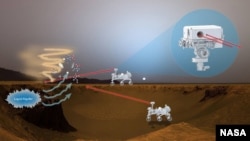An instrument used to detect bio-hazards here on Earth could be used to find signs of current or former life on Mars.
The instrument, developed by NASA technologist Branimir Blagojevic, is called BILI, and is a “fluorescence-based lidar,” which works like radar, but instead of using radio waves, it analyzes light to analyze particles in the atmosphere.
“NASA has never used it before for planetary ground level exploration. If the agency develops it, it will be the first of a kind,” Blagojevic said.
Blagojevic hopes that one day his instrument will be put in a Mars probe where it could analyze dust plumes for “bio-signatures.”
“If the bio-signatures are there, it could be detected in the dust,” Blagojevic said, adding that BILI could detect “small levels of organic materials from a distance of several hundred meters” in real time.
This would be advantageous because many of the plumes are given off from the surface on slopes, which are not easily accessible to a rover.
“This makes our instrument an excellent complementary organic detection instrument, which we could use in tandem with more sensitive, point sensor-type mass spectrometers that can only measure a small amount of material at once,” Blagojevic said. “BILI’s measurements do not require consumables other than electrical power and can be conducted quickly over a broad area. This is a survey instrument, with a nose for certain molecules.”
The next steps for BILI are to make it more rugged and smaller in addition to “confirming that it can detect tiny concentrations of a broad range of organic molecules, particularly in aerosols that would be found at the ground level on Mars.”
New Sensor Could ‘Sniff’ for Life on Mars
- By VOA News








